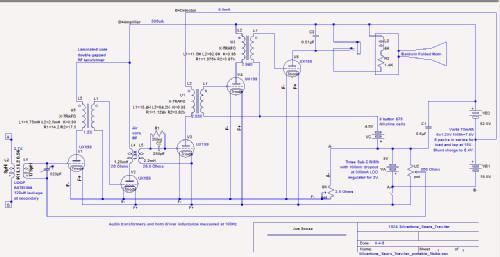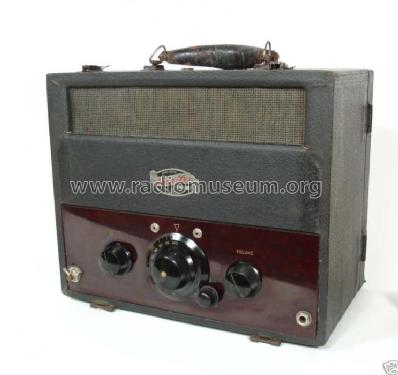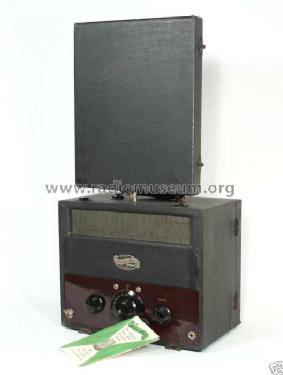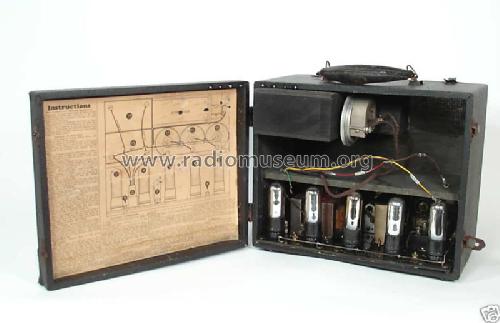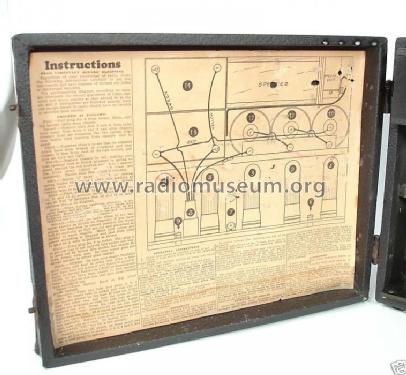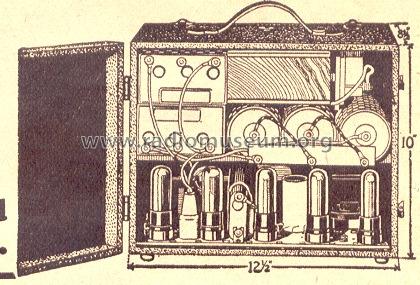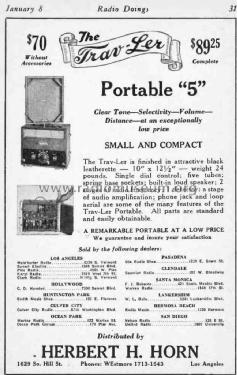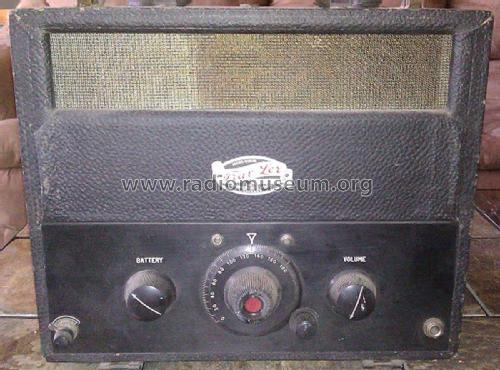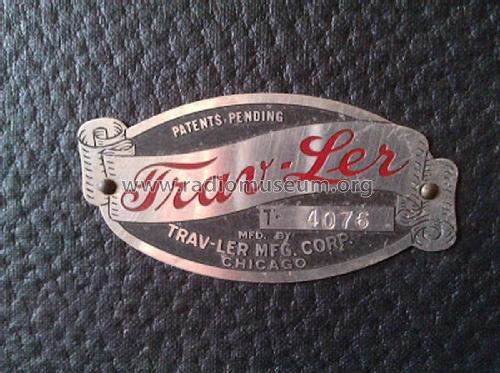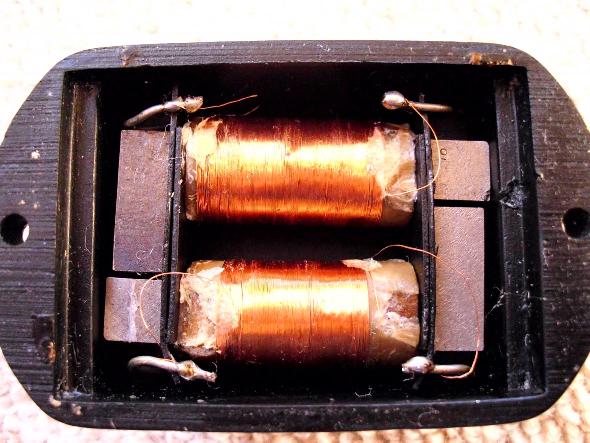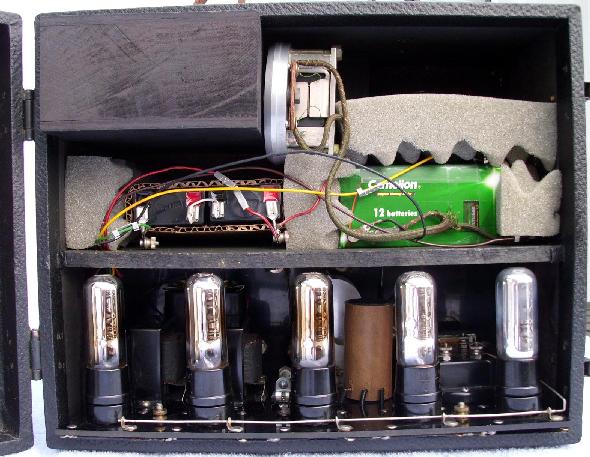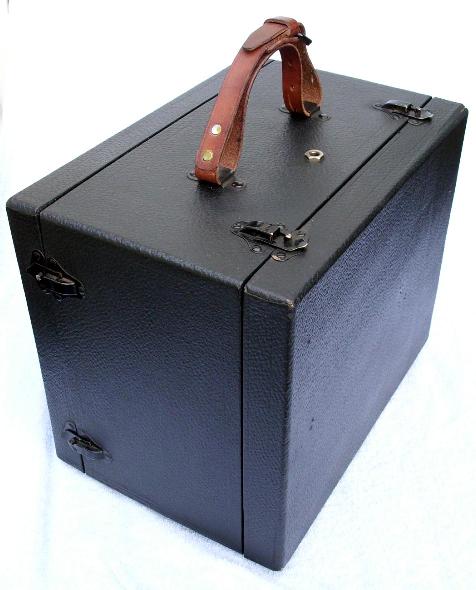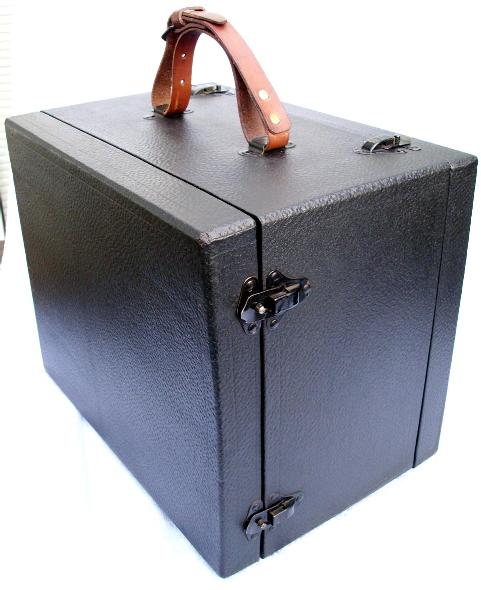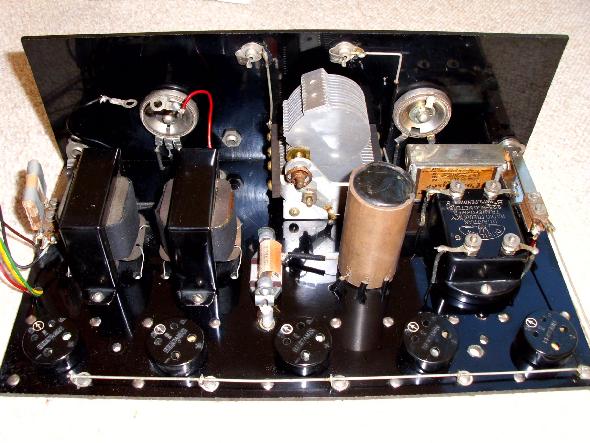- Produttore / Marca
- Trav-Ler Karenola Radio & Television Corp.(Travler); Chicago
- Anno
- 1927
- Categoria
- Radio (o sintonizzatore del dopoguerra WW2)
- Radiomuseum.org ID
- 105450
Clicca sulla miniatura dello schema per richiederlo come documento gratuito.
- Numero di tubi
- 5
- Principio generale
- A circuiti accordati (TRF o amplif. diretta in generale); 2 Stadi BF
- Gamme d'onda
- Solo onde medie (OM).
- Tensioni di funzionamento
- Batterie a secco / 2 x 45 & 3 x 1.5 & 4.5 Volt
- Altoparlante
- Altoparlante magnetico (a spillo)
- Materiali
- Pelle / stoffa / plastica ma con altro materiale sottostante
- Radiomuseum.org
- Modello: Portable 5 - Trav-Ler Karenola Radio &
- Forma
- Apparecchio portatile > 20 cm (senza la necessità di una rete)
- Dimensioni (LxAxP)
- 12.5 x 10 x 8.5 inch / 318 x 254 x 216 mm
- Prezzo nel primo anno
- 77.00 $ !
- Bibliografia
- The Portable Radio in American Life (p.94)
- Letteratura / Schemi (1)
- Western Radio Manufacturing Co. 1929 catalogue
- Letteratura / Schemi (4)
- January 8th 1927, Radio Doings magazine advertisement on page 31
- Autore
- Modello inviato da Vitor Oliveira. Utilizzare "Proponi modifica" per inviare ulteriori dati.
- Altri modelli
-
In questo link sono elencati 620 modelli, di cui 284 con immagini e 520 con schemi.
Elenco delle radio e altri apparecchi della Trav-Ler Karenola Radio & Television Corp.(Travler); Chicago
Discussioni nel forum su questo modello: Trav-Ler Karenola: Portable 5
Argomenti: 2 | Articoli: 2
Fellow Radiophiles:
This post shows the restoration results by Radio Museum guest Michael Lang, who found the information here very helpful to repair his Trav-Ler 5 tube portable radio from the mid 1920's.
One of the problems was the open windings in iron core transformer, which Michael rewound completely. This is not a tuned transformer, so the number of turns is not critical. He was inspired by a post showing the repair of one of these transformers.
Michael also had to improvise a supporting pin for the lid which holds the embedded loop antenna as shown in the next picture. In my slightly earlier version of the radio, I improvised a different pin to hold the loop, which is separate from the lid, as shown the the two pictures on the right.
Date: Tue, 12 Oct 2010 13:48:33 -0400
------------------------------------------------------------
Date: Sun, 17 Oct 2010 18:05:10 -0400
Date: Wed, 20 Oct 2010 12:08:07 -0400
Thank you Michael for sharing your very good photos. We look forward to your joining RMORG.
-Joe
Joe Sousa, 31.Oct.10
Hello Radiophiles,
Ross Hoff has posted a useful method to work around an open untuned RF transformer primary. Ross made his repair on a Crosley 127 Superhet.
As Konrad Birkner points out in his reply to Ross, the ideal approach would be actual replacement of the transformer.
Sometimes, a replacement can't be found.
I had good luck repairing the two open untuned transformers transformers in my Silvertone Trav-ler portable radio.
Part of what made the repair easy is that the exact number of turns is of no importance because the transformers are not tuned. The other aspect that made this repair easy is that the number of turns is not too large.
Often the fault is corrosion right at the coil wire solder connection. I have fixed a few audio and RF transformer just by resoldering the end wires.
The two transformers of the Travler were open and had opens in the middle of the winding that were caused by corrosion. I found the open spots, added a similar ammount of fine wire, and got the transformers working again.
In my case the RF transformers offered a modest amount of step-up gain around 1.3X per transformer.
The transformer load also eliminates plate resistor drop, which reduces plate voltage on a triode and therefor, it's transconductance. This is particularly important if the plate supply is a modest 90V.
click to enlarge photos
The second transformer shown on the right has a wood core, and only need to have the internal wires reconnected. They had corroded open at the point where they exit the transformer.
Regards,
-Joe
Joe Sousa, 13.Oct.09
